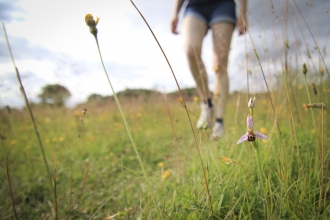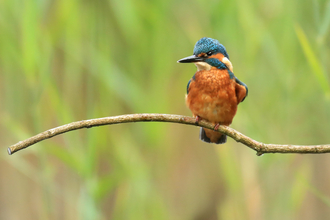From elegant waders to wonderful warblers, find out what to look out for on your outdoor adventures this month.
Latest wildlife sightings – April 2019
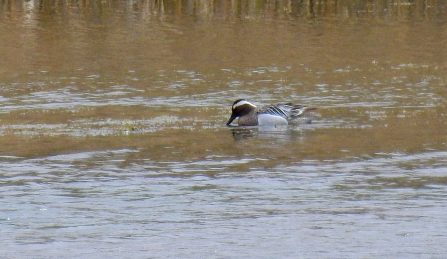
Male garganey at Brockholes by Jen Coates
Brockholes Nature Reserve
Brockholes was abuzz with excitement as a male garganey took up residence on Meadow Lake. This scarce and secretive duck is very rare in Lancashire but showed well for a few weeks before sightings started drying up. Despite being a brown duck they are far from dull – easily recognised by a bright white eye-stripe.
This wasn’t the only bird that got Brockholes’ visitors in a flap. We also had:
- Our first hobby of the year
- The first wood warbler since May 2000
- Bar-tailed godwit
- Cetti’s warbler
- Dunlin
- Yellow wagtail
- Little ringed plover
- Grasshopper warbler
- Whitethroat
- Osprey (flying overhead)
Mere Sands Wood
Our volunteer work parties spent many days shivering in the cold over winter, improving habitat for snipe and willow tits, so it was wonderful to record both of these birds regularly throughout April. The willow tit is the UK’s most endangered small bird, but through our dedicated conservation work across Lancashire and the Wigan Greenheart, we have protected and nurtured a stable population. In fact, more than 10 per cent of the UK population of willow tits lives in the area around Wigan.
Elsewhere at Mere Sands Wood we had our first damselfly of the year (a large red) plus butterflies including brimstone, peacock, painted lady, comma, small tortoiseshell and the stunning orange-tip. Linnets were seen flying to and from gorse bushes on the dry heath which we hope means they might breed here, while regular breeders like blackcaps and reed warblers have been staking out territories.
Encouragingly, it appears as though greenfinches are slowly making a comeback in some of Mere Sands’ woodland areas following a few lean years.
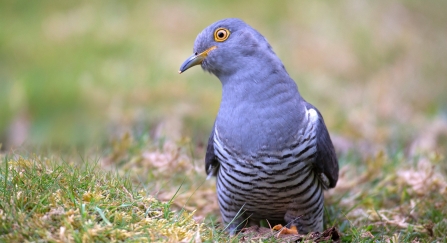
Cuckoo by Jon Hawkins - Surrey Hills Photography
Little Woolden Moss
Though not seen, something very exciting was heard at Little Woolden Moss last month – a cuckoo!
These iconic spring migrants are rare in our region, but lucky sightings do come in from mossland, upland and even some woodland areas. Cuckoos were also heard from Croxteth Park in Liverpool and Haslingden Grane on the West Pennine Moors.
Astley Moss
The Manchester mosses are fantastic places to spot wildlife. As well as a cuckoo on Little Woolden Moss we’ve had brown hares on Astley Moss, a true wilderness nestled just a stone’s throw from the urban jungle. This is a really promising sign that all of our restoration work on Astley Moss is working.
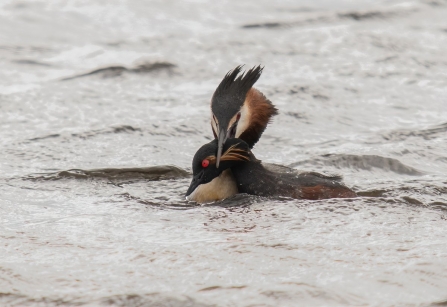
A great crested grebe grabs a black-necked grebe by the neck, by Steve D'Cruze
Lunt Meadows
You can always rely on Lunt Meadows to be a hive of activity. Up to four avocets were spotted on the Great White Pool in April and house martins, sand martins and swallows were all seen swooping over the water on the hunt for insects. An impressive flock of golden plovers (at least 800 birds) fed in the farm fields next to the reserve and threw some serious shapes similar to a starling murmuration. Cetti’s warblers have been calling from the reedy ditches while merlins and marsh harriers were spotted flying through the reserve.
April’s crowning glory, however, was a pair of black-necked grebes on the Great White Pool – only our second record of these rare birds. There is no mistaking those beady red eyes framed by gorgeous golden feathers.
There was even a bit of drama as one of the black-necked grebes got a little too close to a great crested grebe. The latter grabbed the black-necked by its neck and dunked it underwater, but it didn’t seem too fazed, as it went into a lovely courtship display with its mate after escaping.
Middleton Nature Reserve
Warbler numbers are building quickly at Middleton Nature Reserve. April visitors enjoyed a wonderful soundtrack including:
- Chiffchaff
- Willow warbler
- Whitethroat
- Lesser whitethroat
- Blackcap
- Sedge warbler
- Reed warbler
- Cetti’s warbler
- Grasshopper warbler
All of these pretty little birds breed on this brownfield site, and now is the perfect time to visit and spot as many as possible. With large red damselflies also on the wing in April, and a pair of stock doves spotted on-site, there is certainly no shortage of things to see.

Male muslin moth by Ben Sale/Flickr.com, CC BY 2.0
Heysham
The spring migration has brought some more unusual birds into the Heysham Harbour area, as well as some of the usual seabirds we find during our ‘seawatch’ sessions.
Red-throated divers, an Arctic skua, great skua and sandwich terns were spotted by eagle-eyed recorders, as well as 455 eider ducks! A purple sandpiper was seen roosting with a group of turnstones on the wooden jetty, two whimbrel were recorded and, wait for it… we had a pomarine skua in the area! These stunning birds have long spoon-shaped tail streamers and two colour forms: dark with small flashes of white on the wings, and light with a pale breast and dark cap. They are scarce passage migrants that can show up briefly during spring and autumn so we are really lucky to have seen one.
Bird-life aside, we were really excited to spot an adult and juvenile harbour porpoise close to shore, as well as find a gorgeous muslin moth in the moth trap. Only the males are sooty grey, while females are an almost translucent white.
Over at Heysham Nature Reserve the spring sightings kept coming, with grasshopper warblers and sedge warblers heard calling on-site, plus the secretive green woodpecker that has been ‘yaffling’ away for the past couple of months. A holly blue butterfly was a lovely treat, as well as a raven.
Don’t miss out on a bluebell walk
Bluebells are now out in full force on many of our nature reserves, with magical carpets decorating woodlands at Brockholes (Boilton Wood), Longworth Clough, Dean Wood and Warton Crag. Now is the perfect time to venture out for a bluebell walk.


